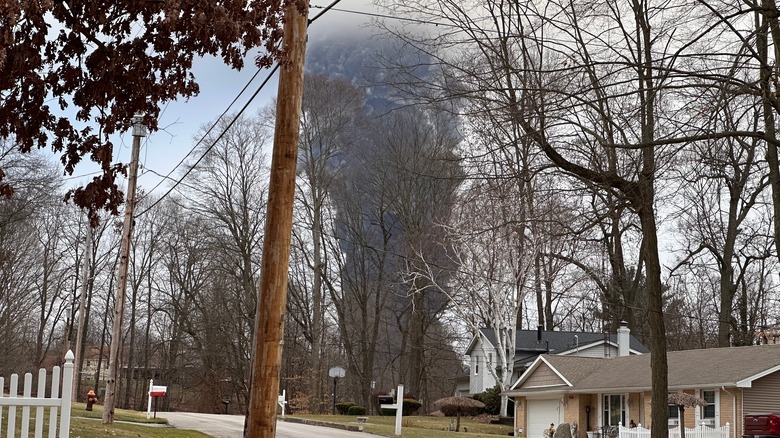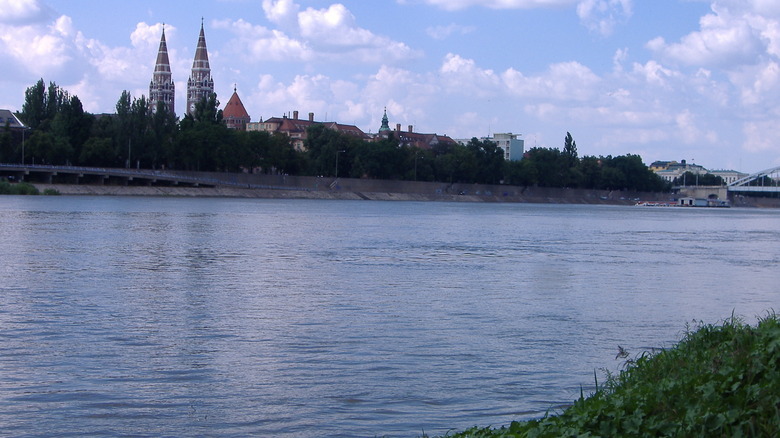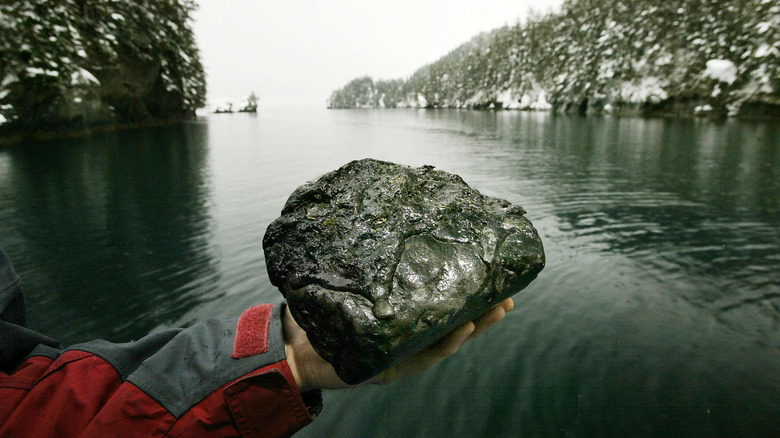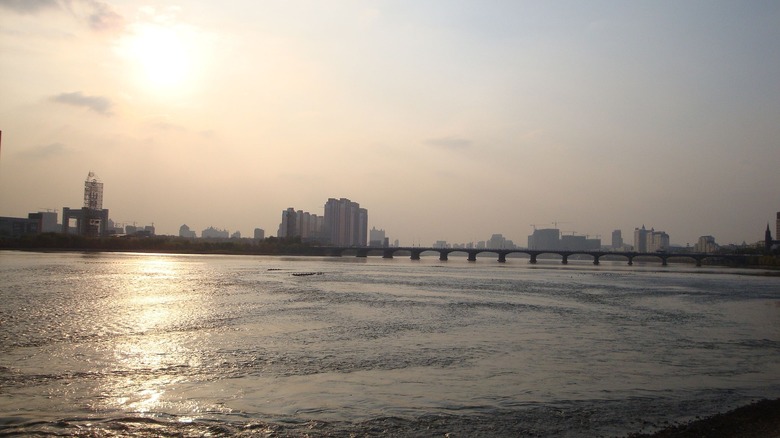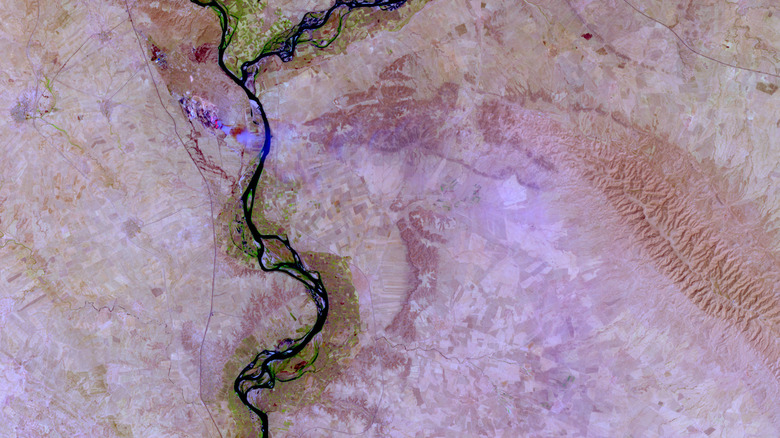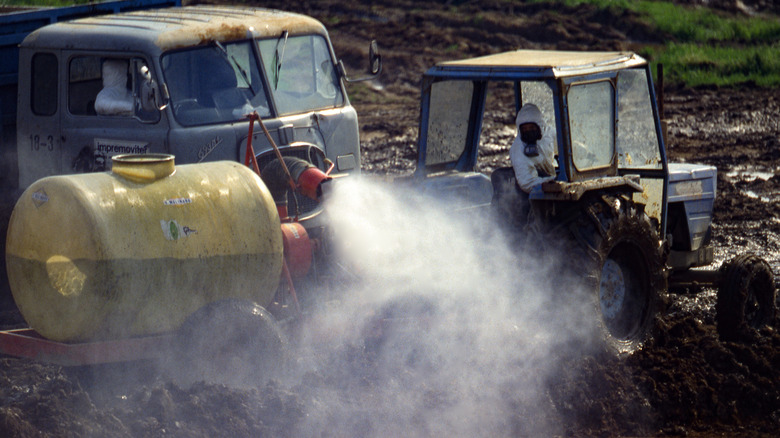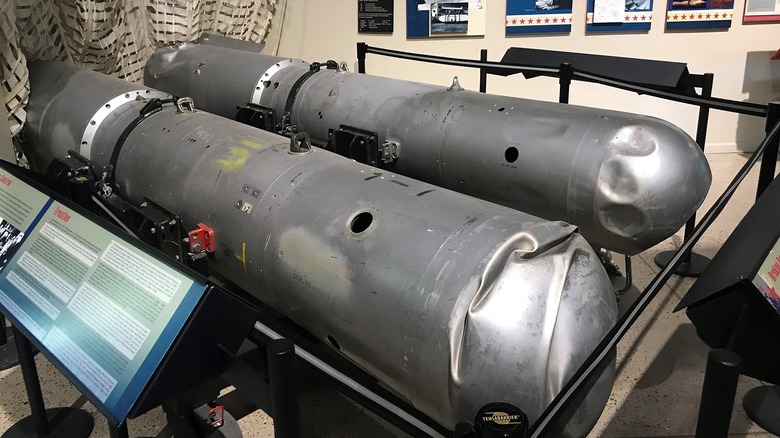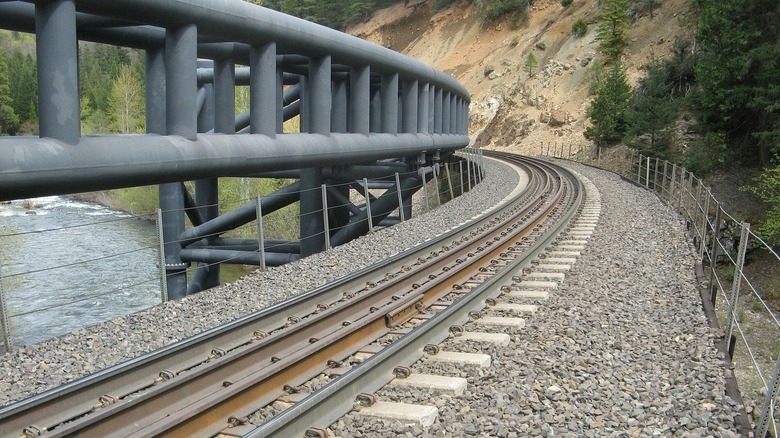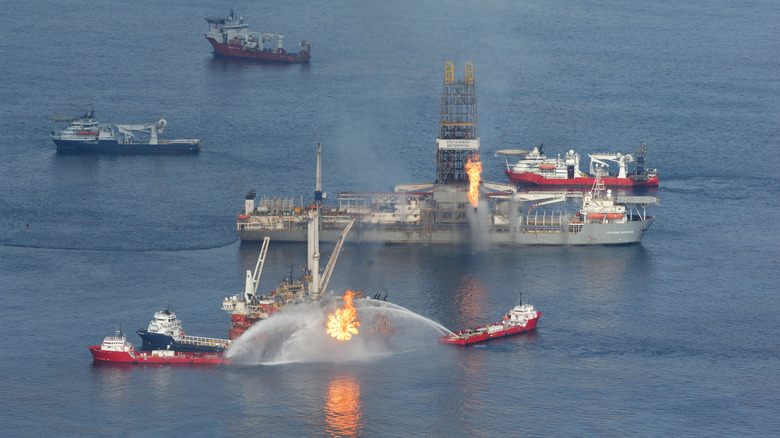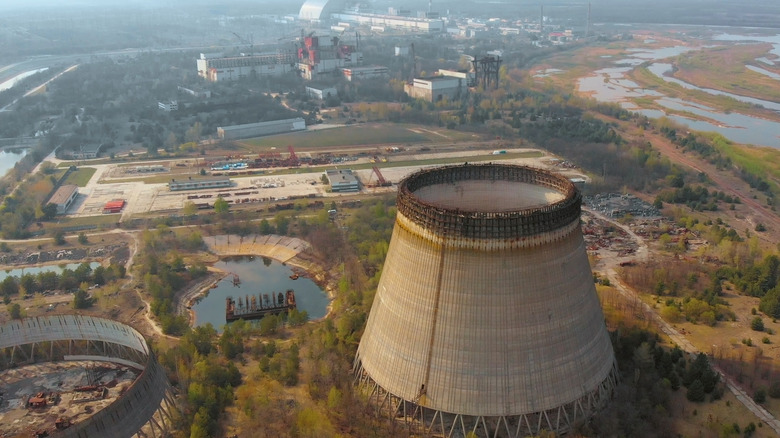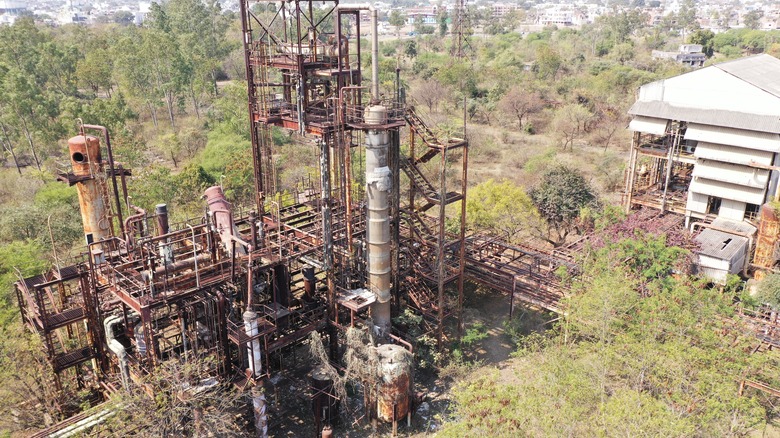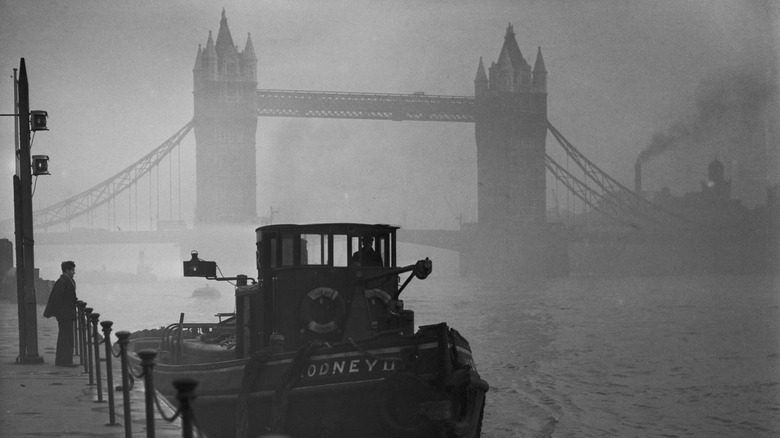The Worst Toxic Spills In History
It was shortly before 9 pm local time, on February 3, 2023, when a freight train derailed near East Palestine, Ohio. The train's crew saw fire and smoke as they discovered that 38 of the train's 149 cars had derailed, 11 of which were carrying toxic vinyl chloride, a known carcinogen. No one was injured by the derailment itself, but engineers grew concerned about rising temperatures and the possibility of an explosion. The safest course of action, they decided, was to do a controlled release-and-burn of the vinyl chloride contained in the train cars, igniting over 115,000 gallons of it. According to The Independent, over 2,000 local residents were evacuated from the area over fears of poisonous gasses from the burn, including hydrochloric acid and phosgene, a compound with a dark history as a chemical warfare agent.
No deaths were reported as a direct result of the incident, and residents were allowed to return home after just 5 days. However, many reported health issues like rashes and headaches. The environmental damage was substantial — and still ongoing at the time of writing — with the Ohio Department of Natural Resources reporting that over 43,000 animals died from poisoning in less than three weeks (via News 5 Cleveland). In the wake of the incident, environmental organizations have called for better regulations on hazardous chemicals and advised locals on possible safety risks. Sadly, this was only the latest in a long line of disasters involving spilled toxic material.
Baia Mare cyanide spill
Waterways often suffer the heaviest ecological damage from toxic spills, and one severe example was the Baia Mare spill in Romania. According to ReliefWeb, this disaster happened on January 30, 2000, when a dam burst at a gold mine in the Baia Mare municipality, spilling over 26 million gallons (over 52 Olympic swimming pools worth) of highly toxic wastewater into the river Tisza, one of the main rivers of Hungary. The cyanide concentration in the river shot up to over 100 times the maximum safe limit for human consumption, but the water continued carrying it further. It soon reached the Danube, one of Europe's longest and most famous rivers, which winds its way through Romania, Bulgaria, and Serbia.
As well as large amounts of cyanide, the wastewater was full of heavy metals which can cause serious and lasting health problems, and doctors grew concerned over the possible long-term health risks for people in the surrounding area. As toxic chemicals poured into the Danube, local wildlife was left devastated. In just two weeks, fishermen needed to remove over 300 tons of dead fish from the water — a tragedy in a place where the river is so cherished and fish are a local delicacy. Ecologists also had grave predictions. At best, they said, it would take over a decade for local ecosystems to be repaired. At worst, the damage was so severe that some worried it might never fully recover.
Exxon Valdez oil spill
Many of the worst toxic spills have been oil spills, and one of the worst in U.S. history was the Exxon Valdez disaster. In March of 1989, this oil tanker ran aground, grinding into a cold-water reef just off the coast of Alaska at Prince William Sound. Eleven million gallons of crude oil poured directly into the sea, leaving the local environment in ruins. Per NOAA, the Exxon Valdez spill claimed the lives of over a quarter of a million birds and thousands of sea mammals. The time of year was particularly unfortunate, as billions of salmon and herring eggs were killed by the oil. This extermination would go on to wreak havoc on both the fish populations and the many animals which rely on them for food. Two and a half decades later, some local species still hadn't recovered.
The Exxon Valdez oil spill was an environmental disaster the like of which the U.S. hadn't experienced before. Over 1,300 miles of coastline were contaminated with oil, including what had previously been pristine wilderness. It also caused a collapse in the local fishing industry. Pockets of oil can still be found around the Alaskan coast, and they're likely to linger for decades more. Remarkably, the Exxon Valdez oil spill isn't even among the top 10 largest in history, but it made such a severe impact that it caused new laws and regulations which reshaped the oil industry — but not enough to prevent many future spills.
Jilin Chemical Plant explosion
In 2005, an explosion at a petrochemical factory in China killed five workers and injured 70 more. The blasts affected a nitration tower in a facility handling benzene, a toxic and carcinogenic compound found in crude oil. According to a report from China Daily, early investigations found no toxic gas in the surrounding area, stressing that benzene combusts into harmless water and carbon dioxide. This early assessment, unfortunately, would turn out to be overly optimistic.
Later investigations found that in the aftermath of the explosions, 100 tons of toxic chemicals (roughly 25,000 gallons) were released into the nearby Songhua river. The chemicals released included benzene, nitrobenzene, and aniline, all hazardous to health, and, with the Songhua river skirting the border of China and Russia, both countries would be potentially affected by the spill. Environmental agencies raised serious concerns over the contaminated water, which rapidly began to damage river ecosystems and affect the water in the nearby city of Harbin. As the city shut off its water supply and brought in bottled water for residents, there were still concerns about how it might affect Russia as the toxic chemicals were carried further downstream, towards the city of Khabarovsk.
Al-Mishraq fire
In Iraq, while under American occupation in 2003, a toxic fire broke out at a sulfur mine near the city of Mosul, the site of one of the world's largest sulfur deposits. Sulfur compounds are frequently hazardous to health, and the huge amount of sulfur dioxide and hydrogen sulfide released by this fire had serious health effects on all those who tried to help contain the blaze. Sulfur dioxide is hazardous because it reacts with oxygen and water, forming sulfuric acid — a chemical reaction likely to affect both the skin and lungs of anyone caught in the gas cloud. American soldiers who tried to fight the fire reported eye irritation, coughing, nosebleeds, and minor burns. The most severe cases had to be evacuated with respiratory problems.
The fire would continue to rage for over a month, releasing over 21,000 tons of sulfur dioxide every day and causing a huge plume of poisonous gas to fill the air above northern Iraq. According to a study published in the journal Atmospheric Environment, the volume of gas released in the inferno was so huge that it was on par with some volcanic eruptions. Acute injuries were reported by people in the surrounding area, some of whom suffered long-term health issues.
Seveso disaster
In 1976, an explosion at an Italian chemical factory exposed nearby residents to high levels of carcinogenic dioxin. This chemical, according to a paper in Environment International, has an unsettling habit of accumulating in people's bodies. It's lipophilic, meaning it tends to be absorbed in fatty tissues of living things, and it can persist in the human body for up to nine years. The explosion caused a cloud of aerosolized chemicals, including the dioxin, which covered an area of almost 7 square miles. Everyone in its path found themselves with nausea, headaches, eye irritation, and skin problems, which were severe enough that 19 children were hospitalized. The spill was so hazardous that the immediate reaction was extreme: plans were made to decontaminate the area by removing all nearby vegetation, together with an entire foot of topsoil.
Humans weren't the only ones to suffer from the effects of the spill; in the surrounding area, 80,000 animals needed to be euthanized. The Seveso disaster is often considered one of the worst industrial accidents in history, and the poor response of local authorities didn't help. It took days before any announcement of the accident was made, and even longer before residents were evacuated. Only two chemical company officials ever faced legal consequences, and victims of the disaster felt they never received justice. The only good thing to come from the incident was that it led to stricter safety regulations for chemical plants, to avoid anything similar happening again.
Palomares incident
The year 1966 saw the worst nuclear weapons accident in history, and a spillage of weapons-grade plutonium. As Boston University's The Brink explains, this disastrous incident happened as a result of a collision between a U.S. bomber and tanker while refueling in mid-air over Spain. Alarmingly, this bomber was carrying thermonuclear warheads which fell onto the Spanish coast with the wreckage. Fortunately, the warheads were unarmed and did not detonate, but two cracked open spilling plutonium into the environment. Plutonium is hazardous in two different ways at once. Best known for its radioactivity, it can also cause heavy metal poisoning. The site was partially cleaned up by the U.S. military but they left behind two trenches of buried radioactive material. Some contamination remained for decades afterward, lingering across 100 acres of land.
Teams worked tirelessly to try and clean up the contaminated area, with around 1,600 people joining in the efforts. Official reports from the military were that cleanup crews wore protective gear, and the official statement was that health risks were low. Unofficially, however, the military personnel deployed to the site tell a different story. According to a report in The New York Times, many weren't even warned about plutonium or radiation, let alone given protective clothing to wear. The result is that there are surviving U.S. Air Force veterans still being treated for multiple cancers as a result of hazardous exposure to radioactivity which the military refuses to recognize even happened.
Cantara chemical spill
Unsettlingly reminiscent of 2023's incident in Ohio, a freight train carrying hazardous materials derailed in California in 1991 on the Cantara Loop railway bridge. It spilled 19,000 gallons of herbicide into the Sacramento river. Per the California Department of Fish and Wildlife, the chemical metam sodium contaminated an area covering 20 miles, stretching from the site of the spillage to nearby Lake Shasta. Residents of the nearby town of Dunsmuir were severely impacted by the spilled chemicals. When mixed with water, metam sodium degrades and forms toxic gasses like methyl isothiocyanate (MITC). People living near the river were exposed to the poisonous gas coming off the water, with terrible consequences. Hundreds required immediate triage and hundreds more were hospitalized. Still more residents suffered minor exposure but mercifully didn't need serious medical care.
The environmental damage was catastrophic. The derailment had essentially dumped a vast amount of poison into a waterway known for both its beautiful scenery and as one of the best fishing spots in the western United States. For three days after the accident, scientists weren't even allowed near the water because it was simply too toxic to approach. In a 38-mile stretch of river, nearly everything died. It's never been quite the same since. While overall, the ecosystems appear to have made an impressively rapid recovery, some creatures which were abundant before are struggling to reclaim their former home. As one biologist explained, "the river is fundamentally changed."
Deepwater Horizon oil spill
The worst marine oil spill in history happened in 2010, in the Gulf of Mexico. Over a decade later, environmentalists still wince at the name Deepwater Horizon. This was an oil rig, operated by British Petroleum, off the coast of Louisiana. It was April 20th when a blast of natural gas from deep underground damaged a seal that had been placed on the oil well. It went on to cause an explosion at the surface which would eventually lead to the rig capsizing and sinking. Worst of all, crude oil began gushing into the sea directly from the open oil well. Pouring out at a rate of up to 2.5 million gallons per day, the resulting oil slick covered an area of 57,500 square miles. It was one of the worst environmental disasters of the 21st century.
According to the NOAA, it took three months to seal the oil well and staunch the flow of oil, by which time 134 million gallons of oil had spilled into the gulf. The environmental tragedy of this cannot be overstated. Entire ecosystems were destroyed, thousands of animals were killed, and their habitats were contaminated with toxic chemicals likely to persist for years in the environment. Efforts to clean up and repair the damage were colossal, and still are. There's a long way yet to go. Estimates say that the ongoing efforts to help the Gulf of Mexico recover are likely to continue for at least 15 more years.
Chernobyl disaster
Possibly the most infamous toxic spill in history released not chemicals but radioactivity. The Chernobyl meltdown is well-known as the worst nuclear disaster in history. During a poorly planned experiment, an explosion tore the reactor open. A raging fire ensued, releasing a plume of smoke filled with radioactive material. The following day, residents of the nearby town of Pryp'yat began evacuating. Free in the atmosphere, the radioactive material was carried on the wind, falling across much of Europe. It was detected in Sweden first, and material from Chernobyl would eventually be found all the way from Russia to France and Italy. An exclusion zone was created around the destroyed power station, eventually designating an area of 1,600 square miles off-limits. Still, many people continued to live on contaminated land.
While the effects outside the Chernobyl reactor were severe, the site itself remained intensely dangerous. Symbolic of the catastrophe is an object dubbed the elephant's foot — a mass of melted material from the reactor core, initially so powerfully radioactive that it could have killed a human within 300 seconds. Even today, it's dangerous to approach. And it isn't the only part of the Chernobyl reactor which is still active. As Science explains, nuclear reactions are still happening inside the destroyed reactor core, simmering slowly. As one scientist explains, "it's like the embers in a barbecue pit." Except that these embers carry a risk that they may yet be able to start an entirely new inferno.
Bhopal cyanide leak
Still widely considered the worst industrial accident ever to occur, the Bhopal disaster of 1984 was as terrible as it was deadly. Located in the city of Bhopal in India's state of Madhya Pradesh, an insecticide plant owned by Union Carbide Corporation accidentally released 45 tons of highly toxic methyl isocyanate gas — a genuinely horrifying chemical that can be toxic at concentrations as low as two parts per million. This poisonous gas cloud drifted through the densely populated areas around the plant. Thousands of people were killed instantly. Many thousands more attempted to flee the deadly chemicals as panic gripped the city. In the end, up to 20,000 people were killed in the incident, and half a million more suffered long-term health problems including blindness and respiratory problems. The soil and water around the site are still heavily contaminated to this day.
According to The Atlantic, in a single night, around 600,000 people were exposed to the toxic gas cloud, which stayed close to the ground where it was most damaging. Decades later, children are still being born with birth defects and disabilities. People have reported stillbirths, miscarriages, cancers, and chronic heart and lung conditions. Many people of Bhopal now feel as if they've been afflicted with some kind of curse. Generations after the initial accident happened, its insidious effects still linger.
Great Smog of London
In the U.K., London sometimes bears the nickname of "The Big Smoke." This moniker dates all the way back to 1874, but it became horrifyingly literal in 1952. Not a single spill but the result of a city packed full of smokestacks and burning fossil fuels, the Great Smog of 1952 was the worst episode of air pollution the British capital has ever known. A lethal blanket of smog choked the city for five long December days. As London was dragged to a standstill, thousands of people died. The smog was so dense and opaque in places, that people standing outside were unable to see their own feet.
As History explains, the Great Smog began innocently enough, as a regular fog on December 5. At the start of winter, people were lighting coal fires to keep warm, and soot from homes, industry, and cars began to stain the fog a dirty shade of yellowish brown. With the whole city belching out thousands of tons of soot, the air itself became toxic. Unpleasantly, with all the sulfur from the new diesel-fuelled busses, it carried the stench of rotten eggs. Windows became coated with a layer of grime, and movie theaters were forced to close because people couldn't see the screens. Following a sharp rise in hospitalizations for pneumonia, up to 12,000 people would eventually die from smog-related illnesses. The incident prompted the U.K. government to create the Clean Air Act which was passed just four years later.
